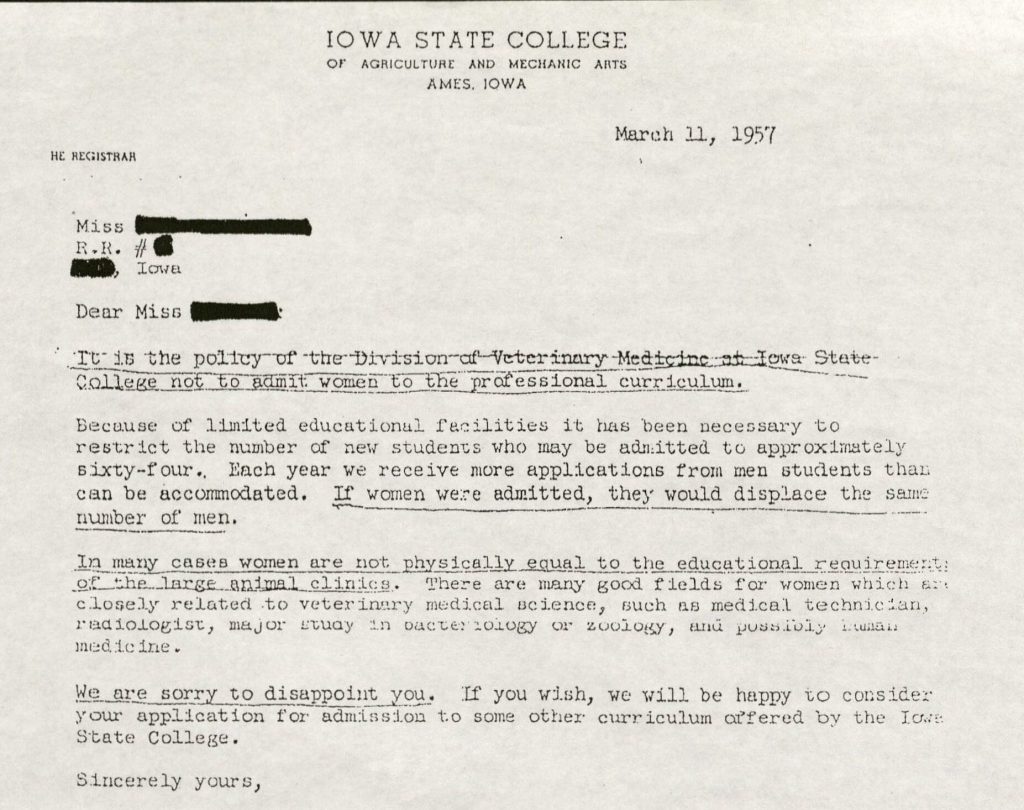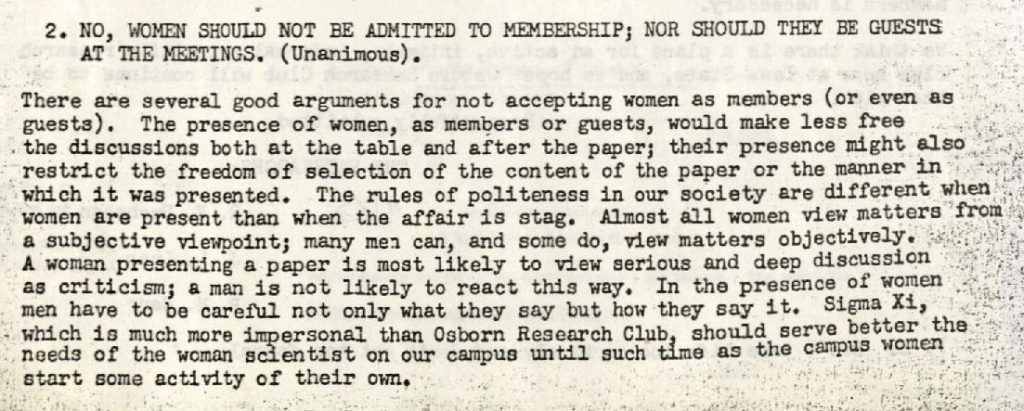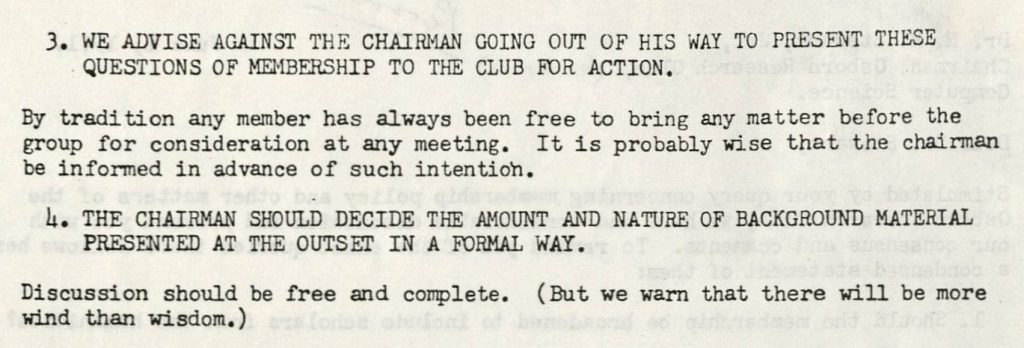Evidence of Exclusion at Iowa State University
Rachael Acheson
Last month, a Special Collections and University Archives blog post[1] on Black History Month and audiovisual recordings referenced the problem of “cultural memory gaps,” which is to say, gaps in the historical record that came about as the direct result of exclusionary attitudes and practices of the time. Sometimes, the loss or absence of a record is noticeable, as was the case with Ralph Ellison’s undocumented visit to Iowa State University. Sometimes, however, this loss or absence takes the form of lost potential, as is the case when members of underrepresented groups are systematically denied access to education, opportunity, and association that might have allowed them to better develop their talents in the first place.
Traditionally, Women’s History Month draws attention to the achievements and contributions of extraordinary individuals who proved exceptions to the rule of their time. It is equally important, however, to remember why so few achievements and contributions exist (at least, in documented form) to celebrate. Today, therefore, we are going to look at material which evidences some discriminatory practices and attitudes connected with Iowa State history.
The first example is a rejection letter from the vet med school, dated 1957.

The picture to the right features a photocopy of the original letter, with the name of the individual to whom it is addressed redacted for privacy purposes. The photocopy also contains markings from a patron who once included the letter in a class guide and wished to draw special attention to the justifications offered for the rejection.
Notice how none of the justifications for rejection reference the applicant’s personal qualifications, but instead emphasize a desire to give male applicants priority consideration based exclusively on their gender.
The practice of discriminating against qualified applicants based on gender ended shortly thereafter, in 1960. Unfortunately, though, the attitudes which shaped the original policy seem to have persisted within the institution beyond the following decade, as there is later evidence of discriminatory practices that limited female students’ access to opportunities for professional development in more subtle ways, even after they had been admitted.
For example, we have a piece of correspondence from 1971, written in the name of the Osborn Research Club and signed by distinguished professors in animal husbandry and bacteriology, one of whom was dean of the graduate college at the time. The purpose of the letter was to establish unwritten policies in response to a challenge, though it is unclear whether this was common practice, as Osborn did not have a constitution at the time of founding.
The Osborn Research Club is a prestigious, now nearly-century-old, group on campus. It is not merely a student club or an honorary, but rather an academic, discussion-based, professional organization, intended to stimulate debate among active researchers in various branches of science. Unfortunately, certain matters were not up for debate.

It is especially interesting to note that, despite the authors’ confidence in the absolute truth of their assertions, there was a pointed reluctance to open this question up for discussion among their reportedly objective-minded members. In fact, the authors of this letter—who, incidentally, signed themselves as “The Patriarchs”—burdened their membership with the responsibility of raising the issue in the first place, perhaps hoping it would simply not come up during their time in office.

But, indeed, the patriarchs’ hesitance to democratize the issue and create “wind” seems to have been well-founded, as the young men of the club voted to admit women in 1972, the year immediately following. Today, the Osborn Research Club counts numerous female researchers among its officers and members. Nor is this the only moment in Iowa State history when students have stood up to their elders in the name of a social justice cause.
In the summer of 1943, the Iowa State chapter of Mortar Board, then an honor society for senior women (now a co-ed honorary for upper-classmen), initiated a letter-writing campaign to debate a national board ruling, which had excluded a highly-qualified black student from joining the Ohio State University chapter, even though the girl’s classmates had already unanimously voted her in.
The letter, after quoting the Mortar Board constitution, summarizes the incident below:
![As you will note after reading carefully our purpose and membership qualifications we have no statement in that which bars a girl because of race, color or creed. However, in the past your Council has made it a policy to admit only members of the white race except where special permission has been requested and granted. This spring one of our chapters unanimously elected a girl of the negro race. This girl has all the necessary qualifications for membership: high scholarship, service to the school, and holds many importatn [sic] offices including that of president ofthe [sic] Y.W.C.A. and A.W.S. board member. The chapter advisors, knowing of our former policy, referred the matter to Council. Since the six members of the Council are so widely separated it was difficult in so short a time to discuss adeqately [sic] the situation and to decide wisely and fairly. also, we did not wish to pass judgment hastily on a matter of national policy of some years standing. Therefore, we reqested [sic] the chapetr [sic] to elect the other new members this spring and if, after our Council meeting, we decided to sanction the election of a negro, this action would be retroactive and the chapter in the fall would initiate the girl in question and she would still have her full year of active membership.](https://iastate.pressbooks.pub/app/uploads/sites/10/2019/04/exclusion-doc3-page-001-copy.jpg)
The language of the Iowa State chapter letter remains carefully diplomatic throughout, framing the issue as one of local democracy, in which each chapter should be allowed to decide on their own admissions policies. It does, however, repeatedly call for response from its sister chapters (implying that the complaint, although addressed to the national president, was not posted privately). It is also filed together with just such a response from the Mortar Board chapter at the University of Washington, and the latter minces fewer words:

Sadly, we have little evidence on the outcome of this specific incident. The folder contains only a reply from the national president, along with a note on onion skin paper from an unidentified alumnae association. Both the president and the alumnae repeatedly, almost redundantly, classify the matter of whether or not to admit black students as a “problem,” find the University of Washington chapter’s tone “belligerent,” and generally agree with the Iowa State chapter that such policies, such “problems,” are best decided upon at the local level. There is no indication of whether or not Ohio State permitted the girl to join Mortar Board, let alone whether she had any remaining desire to do so.
With this lack of resolution in mind, here are a few take-away points:
- Despite what the first two documents examined in this blog post imply, the attitudes and prejudices which shape exclusionary practices, at ISU and elsewhere, are not, and have never been, the sole property of men. Women of color have faced systematic exclusion much longer than, and frequently at the hands of, white women.
- Historically speaking, it is not at all a new phenomenon for young people to champion policy-based change, only to hear their elders patronize and dismiss them for their zeal. In fact, many individuals who make sweeping generalizations about Generations X, Y, and Z today would themselves have belonged to the generations that protested exclusion with such recognizable turns of pandering, “wind,” and “belligerence.”
- The missing pieces from all of these stories are the thoughts, reactions, and even identities of the women whom these exclusionary policies impacted. All of these individuals must have had some perspective on what had happened to them and why. All of these individuals had lives before and after they butted up against the policies. But their stories are filtered exclusively through the words of their oppressors and/or, occasionally, the people who chose to stand up for them. This is unfortunate, because it frames our entire knowledge of these women as victims who required saving, and there is no evidence that this is how they saw themselves. For all we know, they may have been glad to discover upfront how prejudiced these organizations were, or what a potentially toxic environment they had escaped. A number of them may have gone on to be very successful in the context of other institutions, other organizations, or in other fields. Without hearing the story from multiple sides, we have no way of knowing what precisely was lost.
The real loss in all of these cases, then, is the institution’s loss, the archives’ loss, the historical record’s loss. Not only was Iowa State denied many opportunities to boast a role in shaping young talent, but current and future historians have been denied the opportunity to gauge with any accuracy precisely how much damage these exclusionary policies caused, or to whom. All we know for certain is that they existed, they were implemented, and why.
About this entry
Original Post:
Publication Date: March 8, 2018
References
- Iowa State University, College of Veterinary Medicine, Office of the Dean, Administrative Records, RS 14/1/8, Iowa State University Library Special Collections and University Archives.
- Iowa State University, Margaret Sloss Women’s Center, Subject Files, RS 3/6/1, Iowa State University Library Special Collections and University Archives.
- Iowa State University, Mortar Board. Torch Chapter (Iowa State University) Records, RS 22/2/3, Iowa State University Library Special Collections and University Archives.
- Iowa State University, Osborn Research Club Records, RS 20/2/1, Iowa State University Library Special Collections and University Archives.
- See first chapter of the Special Collections and University Archives section. ↵

